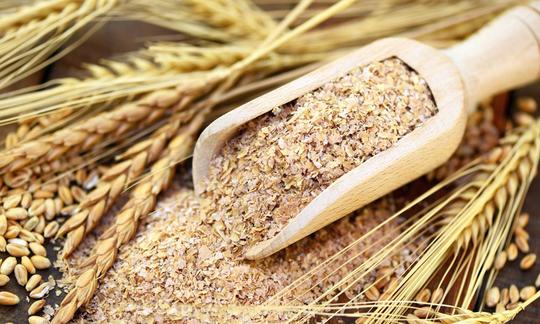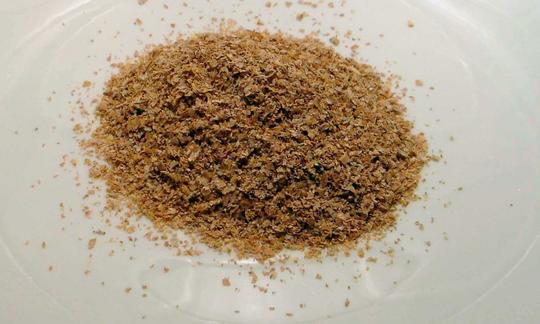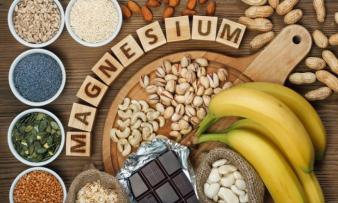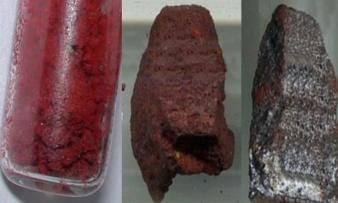Table of contents
Wheat bran ( raw) is a by-product that is produced during the production of flour (especially white flour) from soft wheat ( Triticum aestivum L.) or durum wheat ( Triticum durum Desf.). In the past, the bran was mainly used to feed livestock, but today the nutrient-rich wheat bran is popular as a food supplement and is also available organically in many supermarkets.
Using wheat bran in the kitchen:
What is wheat bran? After grinding and sieving the fine flour, the shell, the aleurone layer and the germ of the wheat grain (= bran) remain. Raw wheat bran can be used in many different ways. Bran has a neutral, slightly nutty to bitter taste.
How much wheat bran per day? The recommended daily amount of fiber is about 25-30 g (with an average of 2000 kcal per day). This corresponds to about 60-70 g for wheat bran, but you can also get fiber from other foods. If your previous diet was low in fiber, it is recommended to start with a smaller amount of bran and increase the dose slowly. This way, your intestines get used to the increased amount of fiber and you avoid stomach pain and flatulence. To stimulate digestion, start with about 10 g of wheat bran per day and increase the amount to 20-40 g per day, depending on how well you tolerate it.
Can you eat wheat bran raw? Yes. However, you should always drink enough liquid with bran (e.g. water or unsweetened tea). Raw bran can also be left to soak in water before consumption, or you can combine it with foods that naturally contain a lot of water, such as fruit or vegetables. Fruit juices are also suitable for soaking, as described in Erb-Müesli. Raw wheat bran can also be used in porridge, yoghurt (vegan) and overnight oats. In bread, pastries, cakes and crispbread, it is possible to replace up to 10% of the wheat flour with bran.
Wheat bran can be used (raw or cooked) as follows: as a substitute for breadcrumbs, to thicken soups and sauces, as a crust for casseroles, in smoothies, as a topping for salads or in pancakes.
In Romania and Moldova, people know Borș, a fermented drink with a sour taste made from wheat bran (possibly also barley bran or corn semolina).
Vegan wheat bran recipe for crispbread:
Ingredients (for 12 pieces): 80 g oat flakes, 80 g spelt flour, 60 g wheat bran (organic), 380 ml water, 40 g linseed, 40 g sesame, 1 tbsp rapeseed oil, salt.
Preparation: First, mix the oat flakes, spelt flour, wheat bran, linseed, sesame and salt in a bowl. Then add water and rapeseed oil and work the mixture into a homogeneous dough. Line a baking tray with baking paper and spread the finished dough thinly on the baking paper. The crispbread must bake for a total of 65 minutes at 170 °C (top and bottom heat), but you must take the tray out of the oven briefly after 15 minutes and cut the dough into 12 equal-sized pieces. Then the baking tray can be put back in the oven and the crispbread can be baked for another 50 minutes. Keep a close eye on the thin crispbreads while they are baking, as they burn very easily.
Vegan wheat bran recipe for low-carb bread:
Ingredients (for 1 loaf): 120 g sunflower seeds, 225 ml warm water, 50 g wheat bran (organic), 50 g walnut flour (alternatives: linseed flour, quinoa flour, soy flour), 35 g chia seeds, 25 g crushed linseed, 25 g psyllium husks, 25 g walnuts, ¼ packet of baking powder, 2 tbsp rapeseed oil, 1 tsp sea salt, ½ tbsp balsamic vinegar (aceto balsamico).
Preparation: Knead all ingredients into a firm dough. A food processor is ideal for this. Then form the dough into a ball and leave to rest for about 10 minutes so that the chia seeds, wheat bran and psyllium husks can swell. In the meantime, preheat the oven to 200 °C (top and bottom heat). Then form the dough into a loaf of bread and bake on a baking tray for 1 hour. Allow the finished bread to cool before cutting. With vegan cream cheese and chopped chives, the fresh bread tastes great for breakfast, as a snack or for dinner.
Vegan recipes with wheat bran can be found under the note: " Recipes that have the most of this ingredient ".
| Not only vegans or vegetarians should read this: Vegans often eat unhealthily. Avoidable nutritional errors. |
Shopping - where can you buy wheat bran?
Where can you get wheat bran? Wheat bran in the form of raw food (often organic) is now available in well-stocked supermarkets such as Migros, Rewe, Edeka etc. In supermarkets such as Coop, Spar, Denner, Volg, Aldi, Lidl and Hofer You will mainly find processed wheat bran products, such as breakfast cereals. Other types of bran (e.g. oat bran) or even wheat germ are often included in the standard range.
Regionally produced, GMO-free, raw wheat bran in organic quality or from biodynamic cultivation ( demeter) can be found in health food stores, organic shops, organic supermarkets (such as Denn's Biomarkt, Alnatura), drugstores, specialty stores or online retailers (e.g. Coop Vitality).
Since contamination from pesticides and heavy metals can accumulate in the outer layers of the wheat grain, we recommend using only organic products (bio).
Storage of wheat bran:
Raw wheat bran is best stored in a dry, cool place, protected from light. Storing the bran in an airtight container in the refrigerator or freezer can prevent moth infestation and delay the raw food from going rancid. Raw wheat bran can be stored for several months under these storage conditions. 1
Wheat bran ingredients - nutritional values - calories:
100 g of wheat bran consists of 65 g of carbohydrates and has an energy content of 216 kcal. With 43 g, it is very rich in fiber and therefore very filling. With 16 g of protein, wheat bran contains more protein than semolina (13 g/100g) and wheat grains (10 g/100g). Chia seeds (17 g/100g) and linseed (18 g/100g) contain more protein. The fat content of wheat bran is 4.2 g/100g. 2
The outer layers of the wheat grain are very rich in nutrients: the nutritional value of wheat bran is 12 mg/100g for manganese. With a daily intake of around 2000 kcal, this amounts to around 575% of the daily requirement. Green andblack pepper have comparable values. The spices saffron (28 mg/100g) and cloves (60 mg/100g) have a significantly higher manganese content. 2 However, people only consume very little of spices. Manganese is important for the formation of cartilage tissue. The body needs the trace element for its carbohydrate metabolism, connective tissue and the urea cycle. 3
Wheat bran contains 611 mg/100g of magnesium, which is an astonishing 163% of the daily requirement. Similar amounts are found in unpeeled hemp seeds (700 mg/100g) and dried pumpkin seeds (592 mg/100g). 2 The body needs magnesium for over 300 enzymatic metabolic reactions and is important for mineralization and bone growth. A deficiency in this essential mineral can lead to osteoporosis, but too much of it can also cause damage. 4
The 1,013 mg of phosphorus contained in 100 g of wheat bran covers 145% of the daily human requirement. Poppy seeds have a slightly lower proportion (870 mg/100g). 2 The unpeeled hemp seeds also have a much higher value here at 1,650 mg/100g. Phosphorus plays an important role in energy production and is a component of bones, teeth and cell membranes. 5 We generally get enough phosphorus from a natural, vegan diet.
Selenium is contained in wheat bran at 78 µg/100g, which makes up 141% of the daily requirement. The relatively high content can be compared with wheat germ and kamut or khorasan wheat. Mustard powder (208 µg/100g) and Brazil nuts (1,917 µg/100g) have an even higher selenium content. 2 Selenium has various functions in the body. The body needs the semi-metal for the immune system, the antioxidant protection system 7 and the thyroid metabolism. However, an excess of selenium can have negative effects and lead to type 2 diabetes. 8
Wheat bran contains nutrients such as iron and zinc, but also vitamins such as pyridoxine (vitamin B6) and niacin (ex-vitamin B3).
The complete ingredients of wheat bran, the coverage of the daily requirement and comparison values with other ingredients can be found in our nutrient tables. In the article Nutrients explained you will get a detailed insight into the topic.
Health aspects - effects:
What is wheat bran good for? Wheat bran is very healthy due to the high concentration of insoluble fiber. This means that wheat bran is used for constipation, flatulence or other digestive problems, because the fiber it contains ensures increased intestinal activity. The long-lasting feeling of satiety can also support weight loss. 11 Regular consumption of wheat bran fiber promotes health with regard to the following diet-related diseases: colon cancer, breast cancer, cardiovascular disease and obesity. 9
In the United States, the average fiber intake of children and adults is less than half the recommended amount (14 g/1000 kcal). Individuals with high fiber intake show a lower risk of stroke, high blood pressure, diabetes, obesity, and various gastrointestinal diseases such as reflux, duodenal ulcers, constipation, and hemorrhoids. 10
Wheat bran contains the secondary plant substance phytic acid. On the one hand, this can bind the minerals contained in food so that the body can no longer absorb them. On the other hand, the acid has a strong antioxidant effect that inhibits the growth of tumor cells, protects against colon cancer and kidney stones, and improves cholesterol levels. 12 You can find more information about phytic acid in the article Phytic acid or phytate and soaking or sprouting.
Dangers - intolerances - side effects:
If you want to incorporate wheat bran into your daily diet, you should only use small amounts to start with and ensure you drink enough fluids. It is advisable to drink a whole glass of water for each tablespoon of wheat bran, as wheat bran swells up a lot. If you do not drink enough fluids, wheat bran can cause constipation and flatulence in the intestines. This is particularly dangerous in the case of a possible intestinal obstruction. In this case, an increased stool volume can cause an intestinal perforation. 13 In such cases, it even helps to significantly reduce fiber intake in order to alleviate certain symptoms. 16
Wheat bran contains gluten. People with gluten intolerance (celiac disease) should therefore avoid eating wheat bran. The disease is defined as a food intolerance that triggers an autoimmune reaction in genetically predisposed patients. Those affected react with an intolerance to the grain protein gluten contained in wheat. 14
However, there can also be a non-celiac wheat sensitivity (non-celiac non-wheat allergy wheat sensitivity, non-celiac gluten sensitivity or wheat sensitivity). Fructans, which are contained in raw wheat bran, are suspected to be the trigger for this intolerance, as they can cause flatulence, stomach pain and diarrhea. Fructans are water-soluble sugars (oligo- and polysaccharides) that are formed from short fructose molecular chains. They are stored as carbohydrates (starch substitutes) in various plants such as artichokes, onions and wheat. 14 But ATI (amylase-trypsin inhibitors) and FODMAP (fermentable oligo-, di- and monosaccharides and polyols) can also be responsible for these abdominal complaints typical of irritable bowel syndrome. 18
People with the rare wheat allergy, in which the ingestion of wheat products triggers an immune reaction, should also avoid consuming wheat bran. 15
Alternatives to wheat bran (wheat bran substitutes) can be found below in the chapter "General information".
Folk medicine - naturopathy:
In naturopathy, wheat bran is used in various masks and creams. They are said to care for the skin and make it glow. Bran can also help with itchy rashes and eczema in the form of poultices. People with sensitive skin can add bran to bath water and the nutrients contained in wheat bran are said to relieve diaper rash in babies.
Occurrence - origin - ecology:
Wheat bran has been part of the human diet since the 19th century. Before that, the bran was used primarily as feed for livestock and poultry. Wheat bran is a so-called milling by-product that arises during the production of wheat flour. Wheat bran consists of the grain outer layers (seed coat and fruit coat), the aleurone layer (honeycomb layer, "milling separation layer") and the germ of the wheat grain.
Ecological aspects:
The ecological balance of wheat bran is very good from a European perspective. Especially when you compare it with chia seeds, which are often referred to as a superfood. Chia seeds are usually from Mexico, South America or Australia and the growing conditions are not entirely clear. Wheat cultivation is very well represented in Europe, which shortens the transport route. In addition, wheat bran is a by-product of flour production and therefore hardly any additional effort is required for its production. Organic wheat bran comes mainly from Austria or other EU countries. 6
Possible confusion:
What is the difference between wheat germ and wheat bran? Wheat bran is sometimes confused with wheat germ. Wheat germ is also contained in wheat bran. Wheat germ is the non-germinated embryo of the grain. It must be filtered out of the bran. The wheat germ is then dried or heated, but not roasted. Whether the wheat germ is still considered "raw" depends largely on the process and the drying temperatures used. Normally, processes with high temperatures are used so that wheat germ can be kept for a long time without butyric acid fermentation (= rancidity). In contrast to wheat bran, wheat germ has a lower swelling capacity because it contains less fiber. 17 This must be distinguished from wheat germlings, which refer to the whole grain in the germination stage.
General information:
What can you use instead of wheat bran? If you want to increase your fiber intake slowly, you can start by eating oat flakes instead of wheat bran. These also contain a lot of fiber and stimulate digestion in the intestines. As an alternative to wheat bran, you can also use other bran products such as oat bran (oat hull bran, oat bran - with a total fiber content of around 12-24% and more beta-glucans 19), spelt bran, barley bran, rye bran, rice bran or hemp bran. Linseed or psyllium husks are also suitable for increasing the fiber content in food. 11
Alternative names:
The singular wheat bran does not exist, and the spellings wheat bran, wizen bran, wheat bran, wheat bran, wheat bran, wheat bran, wheat bran, wheat bran, wheat bran, wheat bran, wheat bran, wheat bran, wheat bran are also wrong.
At feed manufacturers you can also read the term "Krüsch" for bran.
In English, wheat bran is called wheat bran, in Spanish, wheat bran is called salvado de trigo.
Literature - Sources:
Bibliography - 19 Sources
| 1. | Lebensmittel-warenkunde.de Weizenkleie lagern. |
| 2. | USDA United States Department of Agriculture. |
| 3. | Brodziak-Dopierała B, Kwapuliński J et al. The content of manganese and iron in hip joint tissue. J Trace Elem Med Biol. Juli 2013;27(3):208–12. |
| 4. | Castiglioni S, Cazzaniga A, Albisetti W et al. Magnesium and osteoporosis: current state of knowledge and future research directions. Nutrients. 31. Juli 2013;5(8):3022–33. |
| 5. | Foster BL, Tompkins KA, Rutherford RB et al. Phosphate: known and potential roles during development and regeneration of teeth and supporting structures. Birth Defects Res C Embryo Today. Dezember 2008;84(4):281–314. |
| 6. | Codecheck.info Chia-Samen vs. Weizenkleie: Was ist gesünder und nachhaltiger? Superfood-Vergleich. |
| 7. | Avery JC, Hoffmann PR. Selenium, selenoproteins, and immunity. Nutrients. 1. September 2018;10(9). |
| 8. | Rayman MP. Selenium and human health. Lancet. 31. März 2012;379(9822):1256–68. |
| 9. | Stevenson L, Phillips F et al. Wheat bran: its composition and benefits to health, a European perspective. Int J Food Sci Nutr. Dezember 2012;63(8):1001–13. |
| 10. | Anderson JW, Baird P et al. Health benefits of dietary fiber. Nutr Rev. April 2009;67(4):188–205. |
| 11. | Gesundfit.de Weizenkleie. |
| 12. | Silva EO, Bracarense APFRL. Phytic acid: from antinutritional to multiple protection factor of organic systems. J Food Sci. Juni 2016;81(6):R1357-1362. |
| 13. | Miller DL, Miller PF, Dekker JJ. Small-bowel obstruction from bran cereal. JAMA. 1990 Feb 9;263(6):813–4. |
| 14. | Smollich M, Vogelreuter A. Nahrungsmittelunverträglichkeiten Lactose-Fructose-Histamin-Gluten. Verlag: Wissenschaftliche Verlagsgesellschaft: Stuttgart. 2. Auflage 2018. |
| 15. | Lebensmittelunvertraeglichkeiten.de Weizenallergie. |
| 16. | Ho K-S, Tan CYM et al. Stopping or reducing dietary fiber intake reduces constipation and its associated symptoms. World J Gastroenterol. 2012 Sep 7;18(33):4593–6. |
| 17. | Iss-gesund.ch Was ist Weizenkleie? |
| 18. | Andresen V, Menge D, Layer P. Die "Nicht-Zöliakie-Glutensensitivität" (NCGS). Arzneimittelkommission der deutschen Ärzteschaft. Arzneiverordnung in der Praxis. 2018;45(2). |
| 19. | Cui SW, Wu Y, Ding H. The range of dietary fibre ingredients and a comparison of their technical functionality (Kap. 5.3.2 Oat bran). In: Fibre-Rich and Wholegrain Foods. Improving Quality. A volume in Woodhead Publishing Series in Food Science, Technology and Nutrition. 2013. |










Comments